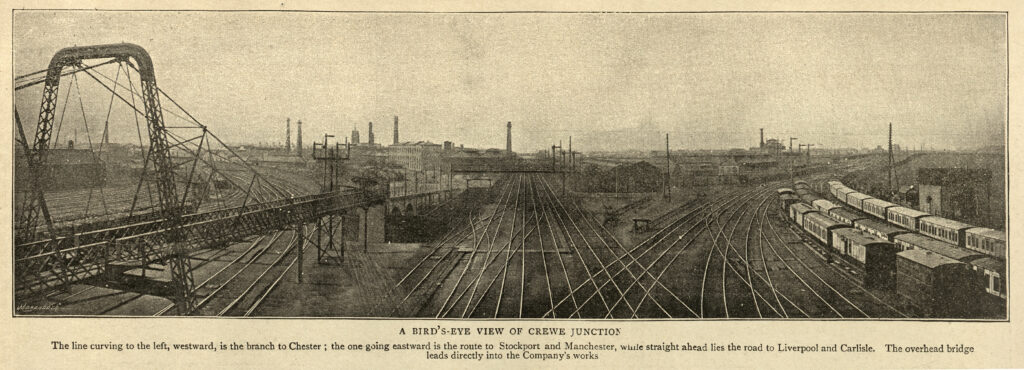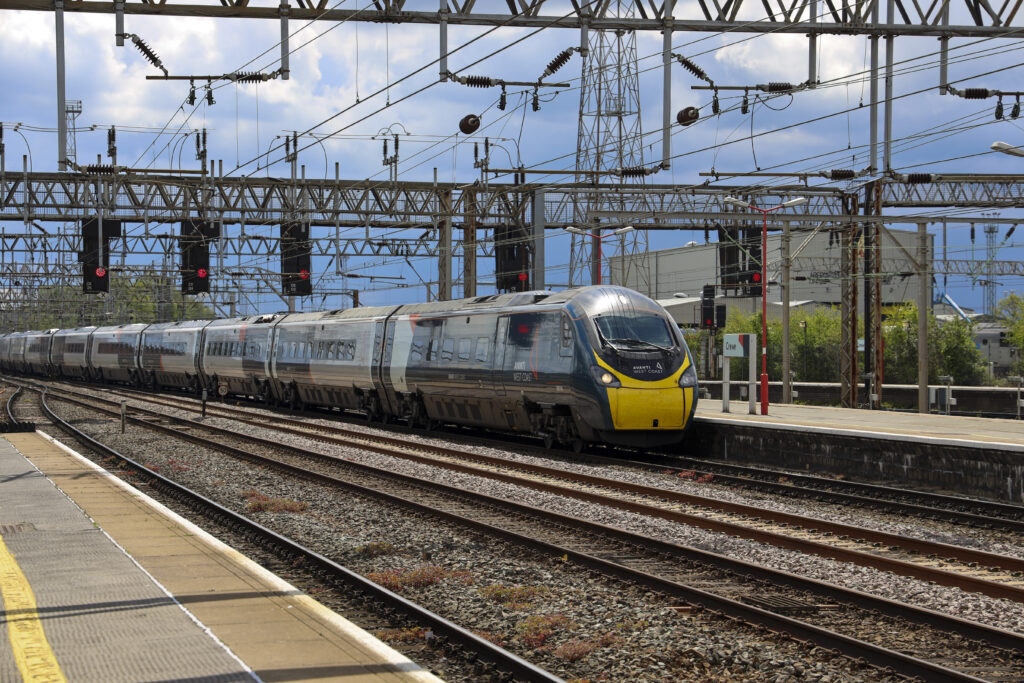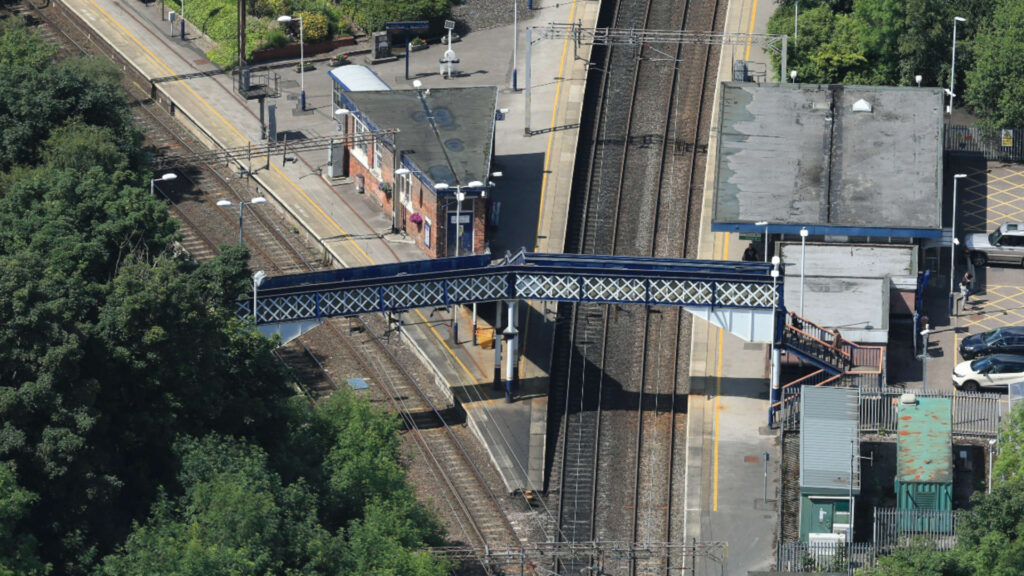In 2021, Rail Engineer reported on the Crewe Basford Hall and Independent Lines (BHIL) re-signalling. BHIL is an early part of the overall large Crewe Hub programme which will consist of many individual projects and phases. In this article we look at the whole programme, which was presented to the IRSE in February by Geoff Paley. Geoff’s presentation was before the two-year delay to HS2 Phase 2, announced in March.
Crewe has always been an important junction on the West Coast Main Line, so its signalling infrastructure is extensive and complicated, with six busy routes and a connection to HS2 to come. The station first opened in July 1837 with Crewe becoming a major junction when the lines to Manchester Piccadilly, North Wales, Stoke-on-Trent/Derby, and Shrewsbury/South Wales were provided a few years later.
It is the last main station before the branch to Liverpool Lime Street at Weaver Junction, with line going on to Scotland. To the south of the station there are lines to London and to Birmingham from Stafford. The station was modernised around 1861 with the Independent Lines tunnels and the Basford Hall sidings for freight trains constructed in the early 1900s, along with an island platform extension on the western side of the station in 1905.
Overdue upgrade
The last major resignalling took place in 1985, with the creation of the Crewe Signalling Control Centre (CSCC) located near to North Junction and the Independent Lines. While this was an extensive resignalling, it did not include the Independent Lines as they were proposed for closure, nor Crewe’s other fringes, and the resignalling only covered the station area and north and south junctions. Today, CSCC is approaching 40 years old, and its asset life is starting to cause problems along with the other much older signalling. The Independent Lines were not closed and remain an important freight route. Salop Goods Junction signal box, which controls most of the Independent Lines dates from 1901 and was last resignalled in 1936.
The 1985 resignalling modernised and simplified the track layout, eliminating many points and crossings and provided 80mph (130 km/h) running over the North Junction. At the same time, all but one of the six 1905 western side extension platforms were taken out of use. Today, even after Covid-19, rail use is increasing and will play an important part in future carbon reduction, so some of the platforms and routes taken out of use 40 years ago are to be reinstated. The CSCC signalling interlocking is life-expired and the canopy structure, installed in 1905 is also in poor condition, with much of it currently needing scaffolding to maintain its integrity.
Health and safety systems are much improved since 1985, as are the testing and assurance processes for signalling work. So, as well as being a much bigger programme than the one that took place in 1985, it must be delivered differently and to modern standards.

Cheshire East Council, HS2 Ltd, the Department for Transport, and Network Rail have developed the Crewe Hub programme, which aims to provide more capacity, better connectivity, more resilience, and improved access and facilities at the station, and to accommodate the HS2 trains that are proposed to call at Crewe and to provide infrastructure to fit with the North West transport strategy. Phase 1 of HS2 involves the railway being built between London and Birmingham, with the line extended from the West Midlands to Crewe in Phase 2a. Phase 2b will connect Crewe to Manchester.
The Crewe Hub programme also includes station renewals and enhancements, station area resignalling and remodelling, and Alsager/Kidsgrove line resignalling which features 16 tricky level crossings. Approximately four miles of the main line will also be realigned to accommodate the HS2 trains calling at Crewe. North of Crewe, Winsford to Weaver Junction is being resignalled along with provision of a northern connection to HS2.
The Crewe Northern Connection will be provided to the north of Crewe tunnel to connect the route of HS2 to the WCML. Crewe North Rolling Stock Depot (RSD) and Crewe North Infrastructure Maintenance Base – Rail (IMB-R) will be located between the route of HS2 and the WCML where they diverge to the east of Walley’s Green. The RSD will serve as an operational and maintenance hub for HS2 rolling stock and the IMB-R will be an infrastructure maintenance facility and storage area for the Proposed Scheme.
Individual projects
The Crewe Programme is a £5.7 billion scheme, made up of Network Rail funding of £1.7 billion and HS2 funding of £4 billion. The ultimate project funder / strategic sponsor is the Department of Transport, with delivery by Network Rail and HS2 responsible for its part of the programme. A small programme lead team will be the ‘guiding mind’ between HS2 and Network Rail. The Crewe Programme is not an alliance but consists of 22 individual projects each with their own profit and loss accounts and contracting strategies.
There are four delivery models for the projects:
Network Rail funded and delivered. Projects include, for example, life extension works and resignalling of the Alsager/Kidsgrove line with level crossings to be closed, upgraded, or renewed. Recontrol to Manchester Rail Operating Centre (MROC) of Gresty Lane, Crewe Steel Works. Independent Lines resignalling and diversionary route upgrades for the blockades of the main station area.
Jointly funded and delivered by Network Rail. This includes the core Crewe station area resignalling, major station works and a new roof, and platform extensions for HS2 trains.
HS2 funded and jointly delivered. Such as the Crewe north and south connections with HS2 and rolling stock depot.
HS2 funded and delivered. This will provide the HS2 running tunnels under Crewe, with Network Rail undertaking the assurance and Asset Protection and Optimisation (ASPRO) requirements.
Much coordination will be required with other projects being delivered around the country during the Crewe Programme, as the signalling and other engineering resources required are huge with many ‘peaks and troughs’ for key people and material. The programme is so big that some of the infrastructure will need life extending until it can be replaced during the later stages.
The life extension works include Crewe station OFF Indicators and Train Ready To Start (TRTS) equipment; Crewe Coal Yard interlocking, Crewe Steelworks interlocking and signals; Beeston Castle & Tarporley signal box diagram and telecoms; and Winsford signal box signals, location cases, and telecoms.

Programme schedule
Barthomley Level Crossing will be renewed in summer 2023 with the crossing made ‘bridleway only’ with no vehicle access and the crossing to be provided with a ‘Flex’ Miniature Stop Lights (MSL) system. This will address misuse issues at the crossing with the gates being left open, and reduce the safety risk with vehicles no longer using the crossing. A vehicle turning space large enough for refuse vehicles will be created to serve the old crossing keeper’s cottage, which is now a private residence. Product acceptance of the changes to the Flex MSL system to accommodate the method of working at Barthomley Level Crossing with protecting signals is another work stream for the Crewe Programme. Work is also required to strengthen an overbridge for a farmer to use instead of the level crossing.
There are a total of 15 crossings on the Alsager Kidsgrove line with two of these being in the top five list of unsafe crossings in the North West. The aim is to close as many as possible and improve the safety of others commencing 2024 as agreements are reached. Any change in level crossing design is not easy and requires much consultation with users, authorities, and risk assessments. The time and work involved must never be underestimated.
Crewe Carriage Sidings level crossing to the south of Crewe and on the Alsager line is only a small crossing for staff use into the depot, but it is one of the highest risk crossings in the North West and is the only access to the carriage sidings. Closure of the crossing will require building a total new access road across fields and the work underway has come across an environmental issue by disturbing some white crayfish. Austropotamobius pallipes is an endangered European freshwater crayfish, and the only crayfish native to the British Isles. Nothing is ever easy with level crossings!
Work underway
Work is already underway to deliver the outline design stage for the resignalling of the Alsager line to Kidsgrove and the level crossing renewals, with completion in 2025. This will include recontrol to the MROC, which will also require work in the ROC on the second floor to create the workstation with hardware and software changes. Renewal of the manual-controlled CCTV level crossings with obstacle detection at Alsager and Radway Green will also be delivered in this stage. The resignalling of the line is a critical enabler for the Crewe area works for train diversions.
Basford Hall and Independent Lines should see commissioning in 2025 with ‘digital ready’ colour light signals, control from MROC, and resignalling to passenger train signalling standards to support future train diversions for later stages of the programme. Speed increases for freight trains and enhanced drainage and track renewals will also be provided to improve asset integrity, as there is a significant flooding risk on the route.
A second signallers training terminal with be provided in the ROC and the project will also provide bi-directional signalling on the Up Independent Chester line. The project is 163 Signalling Equivalent Units (SEU), and so is a major resignalling project in itself, never mind being part of the Crewe Programme. Under-track crossings and overhead line work is already ongoing as part of the 20-stage works required.
Crewe South connection offline build is currently scheduled for 2025 – 2028 and to accommodate HS2 civils preparatory works. This will involve the off-line diversion of WCML 60 metres west to create space for the HS2 connection works, along with major civil engineering works associated with HS2 for bridges, grade crossings, and utilities.
Crewe station core works area
The Crewe station core area works should be delivered in 2028/2029, with the Crewe area fully resignalled and re-controlled to MROC with the provision of colour light signals and ‘digital ready’ signalling. The layout will be enhanced for additional services, which includes putting back some of the platforms on the western side of the station which were taken out of use in 1985, and provision for HS2 trains with longer platforms – 500 metres in total. The station renewals work, including a new station roof canopy, will also enable the HS2 southern connection build. As much pre-work will be delivered offline as possible, but a major blockade with diversion of WCML services via the Independent Lines and Stoke is likely to be required. The work involves 106 points, 89 signals, along with 18km of track, traction power immunisation, an Autotransformer Feeder system (ATF) commissioned, and 24km of overhead wire replaced.
To illustrate the size of the work required there will be 669 signalling routes provided. Birmingham New Street commissioning (which was a large blockade last Christmas) was only 325 signalling routes: less than half the size of just the Crewe station core area. The exact staging is to be determined but many small stages are planned, with the aim of retaining as many services as possible during the blockade(s). Station power supplies, stairways, and passenger entrances are just some of the other works that have to be accommodated into the extremely busy programme.

Some of the overhead line equipment is supported by the delicate station roof structure, so alternative structures will be required to allow the roof to be replaced and, to make things even more difficult, some of the station is ‘listed’. Other work required in this stage is the recontrol of the interlockings at Crewe Steel works and Crewe Coal Yard signal boxes to MROC.
The station is in need of improvements to meet future passenger growth, and to accommodate HS2 400 metre services and dwell times to provide a coherent experience for passengers using a high-speed station. To meet passenger growth based on the new station platform layout (and moving the station operating area in effect 80 metres south) there is a need to increase the size of the Nantwich Road entrance, concourse, and gate lines. Wider stairs to the platforms and the upgrade of the subway for passengers to access the western platform island, will also be required.
Challenges
In designing the work, the Crewe station core works team must meet regulatory compliance and work closely with the ORR to ensure National Technical Specification Notices (NTSNs) compliance. The station operator must also ensure a fully accessible, safe, and secure station. The station layout will also make provision for a new transfer deck to Weston Road and will integrate the station and canopy design into the wider rail systems work. The same designer will be responsible for the rail system, platform civils engineering, track, and overhead line, as well as the station works to reduce the contractor interfaces.
Key challenges include the fact that the work will impact all six routes in and out of Crewe station and there are many stakeholders that will be affected, including freight and train operators, depots, and Cheshire East Council. The logistics are demanding with limited access and temporary land takes, as Crewe is a lot more built up than it was for the 1985 resignalling. There will be a reliance on Basford Hall Independent Lines and Alsager line resignalling being completed on time, as the diversionary routes will be critical. Early track access to carry out as much preliminary work as possible will also be required. The volume of work will also create a resource demand for the whole rail network.
Crewe South connection’s tie in to WCML and HS2 will follow the Crewe station core area stage, which will include provision for an ETCS overlay for the area. This is likely to be during 2028 – 2034, which should also see Crewe North construction sidings, north connection offline build, and Winsford-Weaver re-signalling. Winsford signal box is a ‘hybrid’ box consisting of a lever frame and entrance / exit panel which is in very poor condition with scaffolding supporting the building, so the assets in the area are in dire need of life extension and renewal.
The final stage of the Crewe Programme is planned for 2036 – 2038 with HS2 Phase 2B north connection operational for Crewe Hub trains, and a new timetable for HS2 services calling at Crewe along with HS2 trains operating under Crewe on their route to Manchester.
It’s an exciting time for rail in South Cheshire and Rail Engineer looks forward to reporting on one of the largest and most challenging rail projects in the county over the next 15 years.

